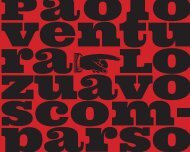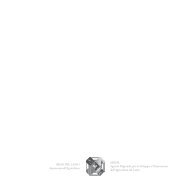Giuseppe Cavalli
Giuseppe Cavalli
Giuseppe Cavalli
- No tags were found...
You also want an ePaper? Increase the reach of your titles
YUMPU automatically turns print PDFs into web optimized ePapers that Google loves.
<strong>Giuseppe</strong> <strong>Cavalli</strong>:<br />
the man who invented fine art photography<br />
Carlo Emanuele<br />
Bugatti<br />
<strong>Giuseppe</strong> <strong>Cavalli</strong> was widely mourned when he died in Senigallia, in 1961, and everyone acknowledged the artistic<br />
genius that had distinguished his untiring activity at a national level.<br />
But although <strong>Cavalli</strong> had devoted much of his energy to teaching while part of the Misa group, there were no<br />
artistic heirs who wished or were equipped to carry on his legacy at a theoretical level, except for Ferroni. He was<br />
the only one who, despite his busy lawyer’s practice, found time to apply <strong>Cavalli</strong>’s lesson with such ideal rigour and<br />
artistic skill that he was named Artist of the Year by the Italian Federation of Photographic Associations (FIAF) in<br />
2006.<br />
Mario Giacomelli and Silvio Branzi had deliberately caused a stir by breaking with the master linguistically some<br />
time previously, choosing to follow paths characterized by powerful Neorealist images, which diverged completely<br />
from <strong>Cavalli</strong>’s poetics based on intuition, harmony and luminous equilibrium.<br />
The increasing international attention later given to Giacomelli’s particular brand of Fauvism put <strong>Cavalli</strong>’s cultivated<br />
creativity in the shade for a long period. At least until historical research into the matrices of fine art photography<br />
in the second half of the twentieth century gave due importance to <strong>Cavalli</strong>’s critical writings for the magazine<br />
Ferrania, and Giacomelli himself returned to the theoretic roots of the dynamics of fine art photography, with a view<br />
to engaging in innovative research and breaking new ground in the future.<br />
This renewed focus on <strong>Cavalli</strong> was strengthened through the establishment of the collections and a body of documentation<br />
at the Museo Comunale d’Arte Moderna, dell’Informazione e della Fotografia in Senigallia, and the<br />
writing of the Manifesto del passaggio di frontiera (Crossing of Frontier Manifesto) by Mario Giacomelli and another<br />
giant of Italian photography, Berengo Gardin, supported by Enzo Carli and other photographers from Senigallia,<br />
whose premises, procedures and aesthetic principles were indebted to <strong>Cavalli</strong>’s methodology.<br />
Later, the commitment undertaken by <strong>Cavalli</strong>’s son Daniele, who first alone and then in collaboration with the<br />
Museum, embarked on the systematic cataloguing of the artist’s works and writings, greatly contributed to boosting<br />
his father’s image.<br />
Today, <strong>Cavalli</strong>’s fundamental role in the invention of Italian fine art photography in the second half of the twentieth<br />
century is becoming increasingly clearer. A role that sprang from his seeing photography as an autonomous art<br />
whose technical means distinguished it from painting but which was equally poetic. A role facilitated by the fact that<br />
his brother Emanuele was not only one of the leading exponents of early-twentieth-century Italian painting, but also<br />
a skilled photographer and familiar with the aesthetic debate on photography.<br />
In the first catalogue of the Mario Giacomelli Civic Collection, I published some of the photographic prints<br />
Emanuele used to send to his artist friends on special occasions or trips. Aside from these documents, it suffices to<br />
say that Virgilio Guidi came out in favour of photography as an autonomous art at the Misa group’s first exhibition<br />
in Rome, expressing a line of thought acquired in the most cultivated Rome circles, which was profoundly influenced<br />
by Emanuelle <strong>Cavalli</strong>’s vision.<br />
The important exhibition staged last year by the Museo di Roma - Palazzo Braschi, in the ambit of the fifth edition<br />
of FotoGrafia – Festival internazionale di Roma, helped to establish <strong>Giuseppe</strong> <strong>Cavalli</strong>’s rightful role in the history<br />
of contemporary art. A role that was recognized in many different milieus, even during the long period before<br />
the cataloguing of his work was complete – although some excellent monographs were published on the occasion of<br />
exhibitions both in Italy and England, despite the silence that followed his death and ended his preeminence as a<br />
theorist of Italian fine art photography.<br />
Daniele <strong>Cavalli</strong> donated the entire corpus of his father’s known photographs to the Museo Comunale d’Arte<br />
Moderna, dell’Informazione e della Fotografia in 2004. This made it possible to create a digital catalogue that can<br />
Director of the Museo<br />
Comunale d’Arte<br />
Moderna,<br />
dell’Informazione<br />
e della Fotografia<br />
(MUSINF), Senigallia<br />
4







